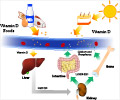Study says overweight or obese women with less-than-optimal levels of vitamin D who lose more than 15 percent of their body weight experience significant increases in circulating levels of vitamin D

According to the National Institutes of Health, vitamin D plays many important roles in the body. It promotes calcium absorption and is needed for bone growth and bone healing. Along with calcium, vitamin D helps protect older adults from osteoporosis. The nutrient also influences cell growth, neuromuscular and immune function, and reduces inflammation. Many gene-encoding proteins that regulate cell proliferation, differentiation, and apoptosis (programmed cell death) are modulated in part by the vitamin.
The year-long study – one of the largest ever conducted to assess the effect of weight loss on vitamin D – involved 439 overweight-to-obese, sedentary, postmenopausal Seattle-area women, ages 50 to 75, who were randomly assigned to one of four groups: exercise only, diet only, exercise plus diet and no intervention.
Those who lost 5 percent to 10 percent of their body weight – equivalent to approximately 10 to 20 pounds for most of the women in the study – through diet and/or exercise saw a relatively small increase in blood levels of vitamin D (about 2.7 nanograms per milliliter, or ng/mL), whereas women who lost more than 15 percent of their weight experienced a nearly threefold increase in vitamin D (about 7.7 ng/mL), independent of dietary intake of the nutrient.
"We were surprised at the effect of weight loss greater than 15 percent on blood vitamin D levels," said senior author Anne McTiernan, M.D., Ph.D., director of the Hutchinson Center's Prevention Center and principal investigator of the study. "It appears that the relationship between weight loss and blood vitamin D is not linear but goes up dramatically with more weight loss. While weight loss of 5 percent to 10 percent is generally recommended to improve risk factors such as blood pressure, cholesterol and blood sugars, our findings suggest that more weight loss might be necessary to meaningfully raise blood vitamin D levels."
About 70 percent of the participants had less-than-optimal levels of vitamin D when the study began; at baseline, the mean blood level of vitamin D among the study participants was 22.5 ng/mL. In addition, 12 percent of the women were at risk of vitamin D deficiency (blood levels of less than 12 ng/mL).
Advertisement
Vitamin D is naturally found in some foods, such as fatty fish, and is produced within the body when skin is exposed to sunlight. According to the Institute of Medicine, just 10 minutes of sun a day is enough to trigger adequate vitamin D production. The estimated average requirement via diet or supplementation is 400 international units per day for most adults.
Advertisement
It is thought that obese and overweight people have lower levels of vitamin D because the nutrient is stored in fat deposits. During weight loss, it is suspected that the vitamin D that is trapped in the fat tissue is released into the blood and available for use throughout the body.
"Vitamin D is found in several different forms in the body and its pathways of action are very complex, so the degree to which vitamin D becomes available to the body as a result of weight loss is not well understood," Mason cautioned.
A possible link between vitamin D deficiency and chronic diseases, including cancer and heart disease, is also not well established. "More targeted research ongoing at the Hutchinson Center and elsewhere aims to better understand whether vitamin D plays a specific role in the prevention of these chronic diseases," McTiernan said. To that end, McTiernan is recruiting Seattle-area obese and overweight postmenopausal women for a separate new study to assess the impact of vitamin D on weight loss and breast cancer risk factors.
Source-Eurekalert















